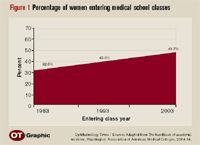Article
Women in ophthalmology-Vive la diff?rence!
Ophthalmology is a man's world-not! At least not for long. While the numbers have historically shown many more men than women enrolling in medical school and entering surgical subspecialties like ophthalmology, things have changed a lot since most of us graduated from school and finished our residencies.

Data from the American Association of Medical Colleges show that the fraction of women making up the student bodies of U.S. medical schools has increased from less than one-third 2 decades ago to one-half today. In 2003, women applicants to medical school outnumbered men (17,672 versus 17,114), for the first time. According to the American Academy of Ophthalmology, today women make up 3,445 (16.5%) of American members. The United States is still slightly behind the rest of the world; when international members of the American Academy of Ophthalmology (AAO) are included, women make up 17.6% of the total. The AAO has only tracked gender of its members for the last 5 years, so while I suspect women are increasing as a percentage over the last 2 decades, I cannot present data to prove this.
Women, men are different I grew up as the only boy in a family with five sisters, have been married to the same woman for almost 23 years, and have two daughters. I hope you will agree that this life experience qualifies me as an expert observer when it comes to the "fair sex." So, at the risk of being castigated like Harvard President Lawrence Summers, trust me when I boldly assert to you that men and women are different. If you have read Men are From Mars, Women are From Venus or have both sons and daughters, you will know this statement to be true.
So what this means is that the field of ophthalmology is going to change, and we all need to figure out how things will change and prepare accordingly. Before long, one-half of the applicant pool for our residency programs will be women. Those ophthalmology departments that want to attract the best medical students will need to make sure they are "woman-friendly" and that they are perceived as being so.
Although this may change over time, women still disproportionately provide care for children and supervise in the home.
Many universities already are realizing the need to adjust the "tenure clock" if a female faculty member has a child; a growing number of universities allow 2 more years for women with children to publish, obtain grants, and otherwise prove that they are worthy of tenure. Attracting only the best male residents and faculty won't cut it any longer, and departments that cannot compete for the best women will become second class.
Practices looking to attract the best young associates will need to make sure they address the issues that young female ophthalmologists may have-such as, in some cases, the desire to work less than full-time, to have flexibility in work hours as needed to balance work and family, to "share jobs," etc. Is your practice "woman-friendly"?
Because some female physicians marry male physicians, it will probably become increasingly necessary to provide men the same type of flexibility, so they can share in meeting family needs. We more senior male physicians are increasingly going to have to cut our young male colleagues some slack, because they are often married to high-powered professionals as well. With two-career physician couples, both will share time that is cut back at work or one spouse will need to cut back time at work.
Newsletter
Don’t miss out—get Ophthalmology Times updates on the latest clinical advancements and expert interviews, straight to your inbox.




